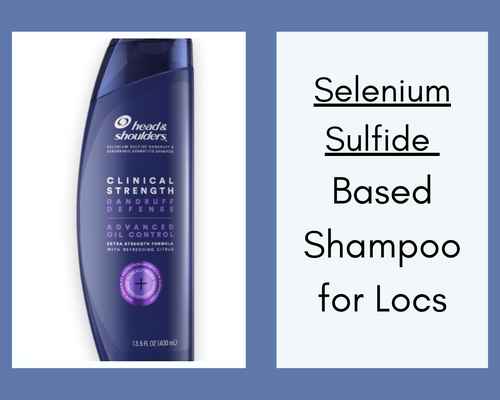There are a lot of products designed to remove dandruff from the scalp. So which do you choose? Below are the main active ingredients clinically proven to get rid of dandruff and dandruff shampoos with those ingredients. Overall, These ingredients work in different ways and have different pros and cons.
Dandruff Shampoos by Active Ingredient
Take a look below at 6 active ingredients for dandruff in shampoos.
Selenium Sulfide Based Shampoo for Locs
Selenium sulfide is seen as a potent dandruff agent with a higher likelihood of causing irritation. Many find the scent to be off-putting. Thus due to that, along with the irritation, many people may want to try other options first.
As for the ingredient, it works by a few ways, one of which is slowing the growth of yeast (malassezia) known to cause dandruff. Researchers also have found the ingredient to be antibacterial and antifungal, which can help with dandruff. It also is used to treat a skin condition known as tinea versicolor. On the other hand, it’s noted to be an irritant, which at least two places (The EU and Japan) have banned/restricted their use in cosmetics. Another adverse effect is excessive oiliness after use.
Concentrations: 1% – 2.5%
Products:
Coal Tar Based Shampoo for Locs

Coal tar is another effective anti dandruff solution used to treat dandruff and psoriasis. Shampoos with coal tar tend to have a distinctive scent. The mechanism it works is by slowing down the growth of skin cells as well as making the skin better shed existing dead skin cells. Adverse effects include irritation as well as skin/hair color staining.
There is this one, which tauts coal tar based shampoos as more effective than pyrithione zinc. However, keep in mind it was 100% supported by Neutrogena, who developed a coal tar anti-dandruff shampoo.
Concentrations: .5 to 5%
Products:
Pyrithione Zinc Based Shampoo for Locs

Pyrithione Zinc (PZ) is probably the favorite ingredient for shampoos to treat dandruff. It is well tolerated and tends to work well. In fact, at the end of a week one part in a study, dermatologists noted 1% pyrithione zinc to perform better reducing scaling compared to 2% ketoconazole. Moreover, PZ is both anti-bacterial and anti-fungal, so that helps as both bacteria and fungi. Overall, this active ingredient is used to treat dandruff, eczema, and acne. It is important to note it was banned in the EU due to the potential ability to damage DNA. Thus, if you are in the EU, the formulation you are buying most likely no longer has this active ingredient.
Concentrations: .3 – 2% (wash off for dandruff)
Products:
Ketoconazole Based Shampoo for Locs

Ketoconazole is a popular ingredient in dandruff shampoos. It’s on par with Pyrithione Zinc (PZ) based shampoos. However, there is not as many Keto-based shampoos on the market as there are PZ shampoos. Thus, if you prefer shampoos without parabens/sulfates/etc, it is likely a bit more difficult to find that OTC with Keto-based shampoos. Moreover, ketoconazole is anti-fungal and not anti-bacterial. While anti-fungal is very important for treating dandruff, there are some bacteria is associated with dandruff as well.
Overall, the ingredient is an antifungal commonly used to treat some conditions such as athlete’s foot, dandruff, seborrheic dermatitis and tinea versicolor. Adverse effects include hair texture change, scalp/hair dryness/oiliness.
Concentrations: 1-2% (1% over the counter; 2% requires a prescription in the US)
Products:
*** Loc Journey Photos From Day 1 to Year 15 ***
Sulfur Based Shampoo for Locs

Sulfur based shampoos probably aren’t the first (or second or third…) you want to grab off the shelf for dandruff. It has a strong scent, and effectiveness is pretty spotty compared to the other ingredients on the list when it comes to treating dandruff.
Sulfur helps with a host of skin conditions such as dandruff, acne, rosacea, and itchiness caused by mites. The ingredient has antibacterial and antifungal properties and is approved by the FDA to treat dandruff. Unfortunately, there are few studies proving its effectiveness by itself to treat it. It is commonly combined with salicylic acid to increase effectiveness.
Concentrations: 2 – 5%
Products:
Salicylic Acid Based Shampoo for Locs

Salicylic acid is a popular ingredient used to treat dandruff and acne. The benefit of it is that it is gentle and the scent is better. However, performance may not be as good.
Moreover, many popular shampoo brands will also carry a salicylic only line along with other active ingredients. Thus, even if you typically buy a certain medicated shampoo brand, it’s important to check out the active ingredient as you may end up with a different product. Dry skin or redness are some of the more common adverse reactions. However, overall salicylic acid based shampoos are well tolerated.
Concentrations: 1.8 – 5%
Products:
Overall Which Shampoo to Pick?
Talking with your doctor can help you make the best decision. Moreover, your dandruff may respond better to a certain product due to the cause of your dandruff and what works best for you. Overall, based on studies, online reviews, and side effects this would be my ranking.
However, remember again that you may need to try multiple shampoos with different active ingredients, and strengths in order to see what works for you. 1% Salicylic Acid Shampoo may not work at all, but 3% works perfectly for you.
—
Which dandruff shampoos have you tried, and which worked best for you? There are a lot of products out there, and unfortunately dandruff is not always straightforward to treat. However, the benefit of all these options is that there may be a better chance you find something that works for your scalp and locs.

